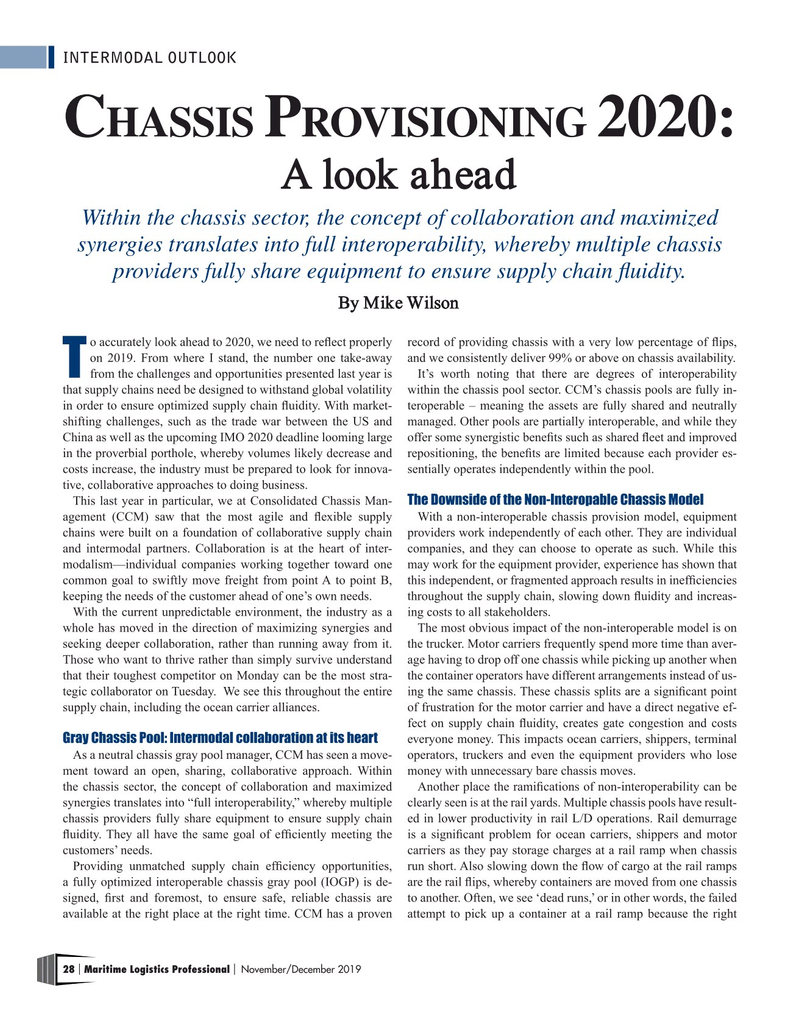
Page 28: of Maritime Logistics Professional Magazine (Nov/Dec 2019)
Short Sea Shipping Ports
Read this page in Pdf, Flash or Html5 edition of Nov/Dec 2019 Maritime Logistics Professional Magazine
INTERMODAL OUTLOOK
C P 2020: hassis rovisioning
A look ahead
Within the chassis sector, the concept of collaboration and maximized synergies translates into full interoperability, whereby multiple chassis providers fully share equipment to ensure supply chain fuidity.
By Mike Wilson o accurately look ahead to 2020, we need to refect properly record of providing chassis with a very low percentage of fips, on 2019. From where I stand, the number one take-away and we consistently deliver 99% or above on chassis availability.
T from the challenges and opportunities presented last year is It’s worth noting that there are degrees of interoperability that supply chains need be designed to withstand global volatility within the chassis pool sector. CCM’s chassis pools are fully in- in order to ensure optimized supply chain fuidity. With market- teroperable – meaning the assets are fully shared and neutrally shifting challenges, such as the trade war between the US and managed. Other pools are partially interoperable, and while they
China as well as the upcoming IMO 2020 deadline looming large offer some synergistic benefts such as shared feet and improved in the proverbial porthole, whereby volumes likely decrease and repositioning, the benefts are limited because each provider es- costs increase, the industry must be prepared to look for innova- sentially operates independently within the pool. tive, collaborative approaches to doing business.
This last year in particular, we at Consolidated Chassis Man-
The Downside of the Non-Interopable Chassis Model agement (CCM) saw that the most agile and fexible supply With a non-interoperable chassis provision model, equipment chains were built on a foundation of collaborative supply chain providers work independently of each other. They are individual and intermodal partners. Collaboration is at the heart of inter- companies, and they can choose to operate as such. While this modalism—individual companies working together toward one may work for the equipment provider, experience has shown that common goal to swiftly move freight from point A to point B, this independent, or fragmented approach results in ineffciencies keeping the needs of the customer ahead of one’s own needs. throughout the supply chain, slowing down fuidity and increas-
With the current unpredictable environment, the industry as a ing costs to all stakeholders.
whole has moved in the direction of maximizing synergies and The most obvious impact of the non-interoperable model is on seeking deeper collaboration, rather than running away from it. the trucker. Motor carriers frequently spend more time than aver-
Those who want to thrive rather than simply survive understand age having to drop off one chassis while picking up another when that their toughest competitor on Monday can be the most stra- the container operators have different arrangements instead of us- tegic collaborator on Tuesday. We see this throughout the entire ing the same chassis. These chassis splits are a signifcant point supply chain, including the ocean carrier alliances. of frustration for the motor carrier and have a direct negative ef- fect on supply chain fuidity, creates gate congestion and costs
Gray Chassis Pool: Intermodal collaboration at its heart everyone money. This impacts ocean carriers, shippers, terminal
As a neutral chassis gray pool manager, CCM has seen a move- operators, truckers and even the equipment providers who lose ment toward an open, sharing, collaborative approach. Within money with unnecessary bare chassis moves. the chassis sector, the concept of collaboration and maximized Another place the ramifcations of non-interoperability can be synergies translates into “full interoperability,” whereby multiple clearly seen is at the rail yards. Multiple chassis pools have result- chassis providers fully share equipment to ensure supply chain ed in lower productivity in rail L/D operations. Rail demurrage fuidity. They all have the same goal of effciently meeting the is a signifcant problem for ocean carriers, shippers and motor customers’ needs. carriers as they pay storage charges at a rail ramp when chassis
Providing unmatched supply chain effciency opportunities, run short. Also slowing down the fow of cargo at the rail ramps a fully optimized interoperable chassis gray pool (IOGP) is de- are the rail fips, whereby containers are moved from one chassis signed, frst and foremost, to ensure safe, reliable chassis are to another. Often, we see ‘dead runs,’ or in other words, the failed available at the right place at the right time. CCM has a proven attempt to pick up a container at a rail ramp because the right 28 Maritime Logistics Professional November/December 2019 | |

 27
27

 29
29
